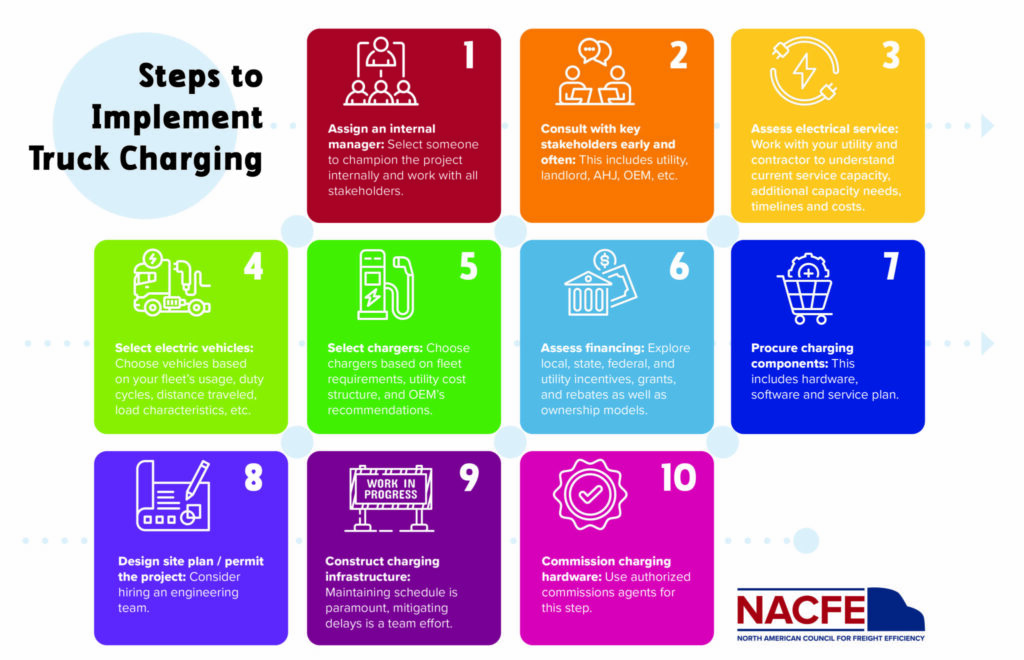NACFE’s 10 tips to roll out electric truck chargers
Battery-electric vehicles won’t get far without the related charging infrastructure. But electrifying an entire fleet involves far more than installing a few outlets or repurposing the power once dedicated to a shop’s welding unit.
“Fueling BEVs economically requires charging in a way that works with the economics of the electric grid: minimizing demand (the maximum rate which your are charging), and maximizing charging during off-peak, low-rate periods (the time of day you are charging),” the North American Council for Freight Efficiency (NACFE) noted when releasing its Charging Forward with Electric Trucks report.

Then there’s the matter of choosing the hardware. Level 2 AC units that provide 208/240 volts AC up to 80 amps, and up to 19.2 kW of power, will fit operations with Classes 3-6 vehicles that return to base and are parked for long periods. But their Level 3 DC Fast Charging counterparts, eliminating the need for on-vehicle conversions from AC to DC, charge at 350 kW or more – making them a better fit for bigger equipment and shorter charge times.
There is a price to pay, though. The council notes Level 2 AC chargers can be secured for a few thousand dollars and only need a dedicated circuit of 20 to 80 amps. The Level 3 chargers can cost US$15,000 to $90,000.
The decisions don’t end there. Other charging-related factors to consider include electrical hardware like transformers, electrical switchgear, conduit and wiring, trenching, landscaping, charger management systems, networking, and maintenance costs, NACFE adds.
“Charging-as-a-Service (CaaS) is new to the industry but gaining traction in the market. A CaaS provider invests in all the assets needed to assure client vehicles are ready to carry out their duties when needed,” the council says. “A CaaS company will select, procure, permit, install and provide power for all the hardware needs to charge your fleet.”
Trucking as a Service businesses take this a step further, allowing drivers to reserve a fully charged BEV.
10 steps when deploying charging infrastructure
Here are 10 steps NACFE recommends when deploying the charging infrastructure for an electric truck fleet:
- Assign an internal manager to champion the project internally and work with all stakeholders.
- Consult with key stakeholders including the utility, landlord, OEMs, and authorities having jurisdiction — early and often.
- Assess electrical service. Utilities and contractors will help understand current service capacity, additional capacity needs, timelines and costs.
- Select electric vehicles, considering factors like fleet use, duty cycles, distance traveled, and load characteristics.
- Select chargers based on fleet requirements, utility cost structure, and OEM recommendations.
- Assess financing by exploring local, provincial, federal, and utility incentives, grants, and rebates, as well as ownership models.
- Procure charging components includinghardware, software and service plans.
- Design the site plan and permit the project. Consider hiring an engineering team.
- Construct charging infrastructure. “Maintaining [the] schedule is paramount. Mitigating delays is a team effort,” NACFE notes.
- Commission charging hardware with support from authorized utility commissions.
“Electric trucks use a lot of power – probably more than you currently have available,” the report notes. “Learn how much power you already have on site to charge trucks, and how much more you will need to get beyond the pilot stage. It is essential that you meet in person with your utility as soon as you begin thinking about electric trucks.”
Have your say
This is a moderated forum. Comments will no longer be published unless they are accompanied by a first and last name and a verifiable email address. (Today's Trucking will not publish or share the email address.) Profane language and content deemed to be libelous, racist, or threatening in nature will not be published under any circumstances.